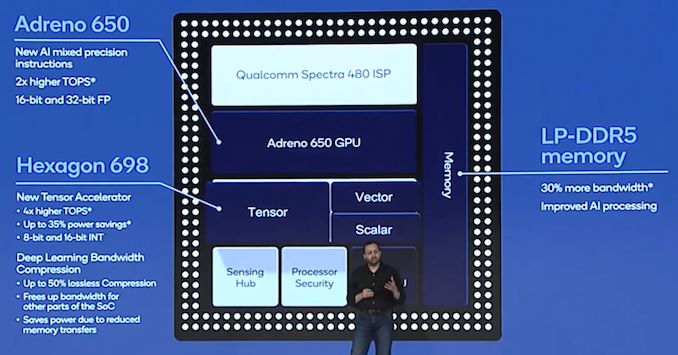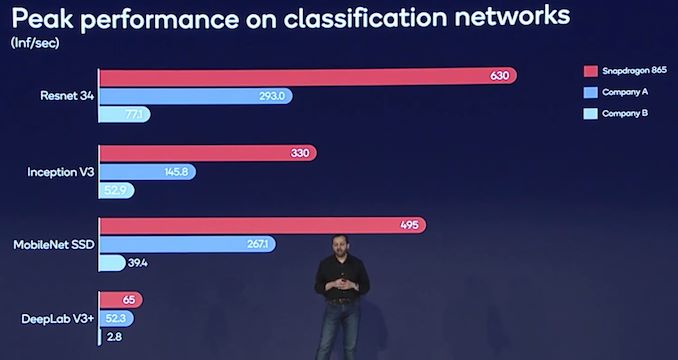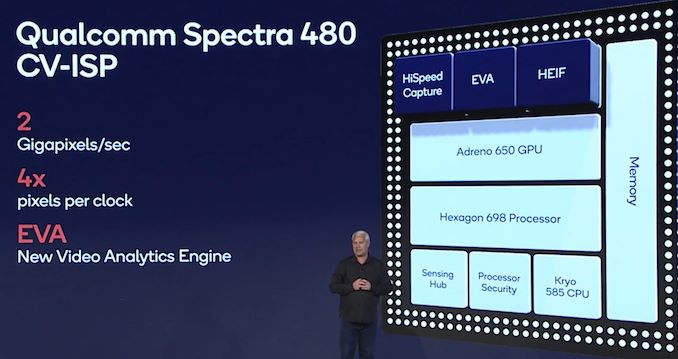Qualcomm Announces Snapdragon 865 and 765(G): 5G For All in 2020, All The Details
by Andrei Frumusanu on December 4, 2019 1:50 PM EST- Posted in
- Mobile
- Qualcomm
- Smartphones
- SoCs
- 7nm
- 5G
- Snapdragon 865
- Snapdragon 765
Immense AI, Camera and ISP Upgrades
New Hexagon 695 DSP: 4x Performance On New Tensor Cores - 15 TOPs Total on SoC
The Snapdragon 865 now ships with the new Hexagon 695 DSP block. The single biggest improvement of the new design is a massive quadrupling of the processing power of the dedicated tensor cores. This jump alone is able to double the SoC’s aggregate AI processing ability up from 7 TOPs to 15 TOPs.
Qualcomm here still doesn’t properly do a breakdown between the IP blocks which contribute to this number, but given that the GPU only saw a ~20% increase, and that the Hexagon’s scalar and vector execution units this year have remained the same in terms of performance, we estimate that the tensor units now roughly come in at around 10TOPs by themselves.
Qualcomm has also now included lossless weight and activation compression for the Tensor cores, being able to reduce bandwidth consumption up to 50%. This is a similar feature we've seen advertised by third-party NPU IP offerings, only that Qualcomm is going to be shipping this now in a product in just a few months.
Power efficiency of the block is also have said to have improved by 35%, making computations less costly in terms of battery life.
Qualcomm talks how about its inference performance and inference power efficiency is significantly higher than competing solutions. We don't know the comparison SoCs being showcased here, but a likely candidates here are the Apple A13 and the Kirin 990? It could also be an Exynos or other SoC.
New Spectra CV-480 ISP: 2 Gigapixels/s Enabling Massive Sensors
Aside from its 5G abilities, it’s very much evident that camera is very much at the very centre of the Snapdragon 865’s new features. The whole camera subsystem has seen some massive upgrades in the IP, and amongst the biggest improvements in capability lies in the new Spectra 480 computer-vision ISP.
The new IP has seen a major architectural change in that it’s now able to process 4 pixels per clock instead of just only 1 PPC as in the previous generation. This has now massively upgraded the pixel processing throughput to 2 Gigapixels/second, allowing the SoC a wide variety of use-cases that in the past simply weren’t possible due to lack of raw power.
Starting off with video capture, the new SoC is able to now record in 4K HDR while simultaneously capturing up to 64MP still shots at the same time. But 4K video isn’t the limit anymore – and you even can say that in terms of framerate as now 4K120 recording is supported, but the Snapdragon 865 now supports 8K30 video recording.
Video recording quality continues to support all the features we’ve seen in the previous generation, meaning 10-bit and various HDR standards such as HLG, HDR10, HDR10+, but now the new SoC expands this even further with the introduction of the ability to do live recording in the Dolby Vision HDR standard. Qualcomm explains that the Snapdragon 865 not only is the first smartphone SoC to be able to do this, but it’s the first camera platform of any kind in the world, as usual Dolby Vision content right now is enabled post-capture in the editing room, rather being something that’s being natively recorded by a camera.
The new improved capabilities of the ISP and video encoder also erase some current recording limitations, for example, slow-motion video recording at 960fps is sustained indefinitely instead of being limited to a couple of seconds of real-time footage.
Although normally I wouldn’t have brought this up, MediaTek’s recent release of the Dimensity 1000 did recently popularise the discussion topic: No, the Snapdragon 865 doesn’t support the AV1 codec for video decoding. It looks like we’ll have to wait for the next generation for that.
In terms of still capture photography, the new ISP performance will now allow for support for sensors of up to 200MP, which actually don’t yet exist as Samsung’s recent 108MP behemoth is currently the largest of its class right now.
The new ISP now has various new functionalities in order to improve noise reduction and contrast enhancements. Particularly the new noise reduction features is said to be quite difficult to achieve.
Although Qualcomm advertises the 200MP figure predominantly, it’s to be noted that actual capture with zero shutter lag (ZSL) is limited to 64MP – so there is a rather larger compromise in capturing at resolutions beyond 64MP.
High Refresh Rate Displays Normalised: Support For 144Hz
Already some vendors are leading the pack in 2019, but we’re expecting 2020 to see wide-range adoption of high refresh-rate displays. Even more importantly, we’ll be seeing implementations at high resolutions higher than 90 and 120Hz, supporting up to 144Hz displays. Qualcomm explains that the barrier that’s been lifted here is the SoC’s Display Processing Unit (DPU) that has had its throughput significantly increased.
I asked the company about the impact on battery life and which component of a phone accounts for the highest power increases. Surprisingly, it’s not any one component, with most of them seeing pretty much just an evenly distributed linear increase in power requirements, with the actual display panel itself (excluding the DDIC), seeing actually the least increases in power draw.















91 Comments
View All Comments
Alistair - Wednesday, December 4, 2019 - link
To be a bit more clear, the touch responsiveness and screen is better with my android, and the text message integration with windows is amazing (bring imessage to windows and maybe I'll get another iphone).Raqia - Wednesday, December 4, 2019 - link
Yeah, there's obvious appeal to the seamless consumer electronics that Apple produces. They have an easier job than the likes of Qualcomm with its dozens of partners and on average end up with better results as well. I'm very impressed with their latest iPad Pro myself.However, their homogeneity poses great risks to consumers and industry competition in the long run. They do not allow competing store fronts on their platform (which they should be forced to open with licensing on FRAND terms) and charge an exorbitant 30% fee to software writers.
Their much touted security may only locally obfuscate severe bugs in their very large ecosystem:
https://www.vice.com/en_us/article/pajkkz/its-almo...
Their treatment of suppliers is downright abusive, cheating business after business such as Dialog, Imagination, and Qualcomm out of their IP and stifling the ability of the industry to support competing products. There are real perils of vertical integration:
https://www.eetimes.com/document.asp?doc_id=133200...
I hope Apple continues to keep the industry on its toes with its excellent execution, but I also hope it opens its platform, by regulatory force if necessary.
generalako - Thursday, December 5, 2019 - link
That's not a fair comparison, seeing as the 4 XL not only has an underclocked SD855, but also UFS 2.1 and not the best software performance optimization. Compare it to a OnePlus 7(T) Pro, which has much faster storage (UFS 3.0) performance, larger and better RAM management and proper performance optimization in both interface and in relation to the CPU, and the difference you claim to see will vanish. Just do yourself the favor and look at comparison videos on YouTube.If software smoothness is what's important to you, I get your grievances. But then again, 90Hz makes up a lot of that (and more), and OxygenOS is probably the most stable and smooth third-party interface on Android after Pixel UI.
name99 - Thursday, December 5, 2019 - link
"the snappiness of iPhones doesn't have especially much to do with peak single threaded integer throughput so much as IO and memory performance coupled with tight integration of iOS with hardware."People keep claiming this. But that SAME tight OS integration has existed on every iPhone since at least the A6 and A7...
Even so, every year I can tell feel the increased fluidity of the new phones. Even at iPhone 6 people were claiming that phones were fast enough, that they never dropped frames. And yet each successive 20% to 30% annual boost is notable in feeling that much smoother, especially as ever more of the UI is built around swiping in different directions rather than tapping.
Are we NOW maxed out? Certainly when I use my A12 and A12X based phone+iPad I don't NOW feel any delays in the UI that bug me. (Every year it's got better; with iPhone 6 it was at the point of "thank god I don't have to wait", since then it has been "yes, definitely smoother, no stuttering, feels right").
And you could say, at this point, OK, good enough, we don't need to do more. Certainly plenty of people seem to think that way (many on the Android side, at least some on the Apple side). But there's is still so much more phones COULD do. Where's my real-time translation (text and speech)? Where's my assistant fixing my typos at the sentence and paragraph level, rather than at the basic (and not THAT accurate) word-by-word level?
If you change the question from "is my phone now fast enough" to "what would I like my phone to do, to hell with practicality or current software technology" you look at CPU design in a very different way.
Apple is certainly on that second track. ARM and QC I think also are for the past few years, though it's not an especially natural place for them, and I wouldn't be surprised if the inside voices pushing for excellence are in a fragile position, liable to be ousted if there's a single false step...
Raqia - Thursday, December 5, 2019 - link
CPUs aren't responsible for much of the heavy lifting in the tasks you're describing like smooth UX scrolling or voice translation. They handle control general purpose program flow which is memory intensive or dynamic recompilation which can bottleneck in some cases like browser execution of Javascript or during just plain benchmarking scenarios.The small cores, larger caches, better buses / IO, GPU compositing functions, and the new AI units are much more responsible for typical user experience than peak CPU single threaded performance, and indeed Apple excels here too but not to the degree they do over Android SoCs in the single threaded metric. Apple is riding high on the positive wave of press and user perception over its excellent CPU performance though due to its being one of the only components on an SoC that's easy to systematically benchmark and publicize.
Sharma_Ji - Wednesday, December 4, 2019 - link
If you get time some someday, use some snappy android phones from likes of 1+, Asus, etc.Ironchef3500 - Thursday, December 5, 2019 - link
I am starting to feel the same way..generalako - Thursday, December 5, 2019 - link
That gap is NOT widening. It is closing. SD855 essentially cut the gap by a 40%, to its lowest point in many years. Even SD865, with A77, is making sure that gap has not widened (in fact, slightly decreased). So your comment is false.Where the gap has been widening, is in Apple's efficiency cores and in GPU performance, however. Here, ARM and Qualcomm have a lot of work to do.
Kabm - Wednesday, December 4, 2019 - link
Now there are a market for gamer chip. But before QC don't have room as Apple as they have integrated 4G modem. The 865 is the first to have the same room as Appleksec - Wednesday, December 4, 2019 - link
While Geekbench is not a perfect benchmark ( No Benchmark is ever perfect ), it is a good tool to estimate performance.The best Single Core Performance of 855 is around ˜710, so a 25% increase would be around 900. an iPhone 8 does 900+, iPhone XS does 1100, and iPhone 11 does 1300.
Of coz MultiCore would blow past iPhone X or even XS. But I dont care much about MultiCore Performance. You are still fundamentally limited by Single Core performance.
And of course, your System Performance ( Not your CPU performance ) depends a lot on Software, NAND Speed, Controller, Memory etc.